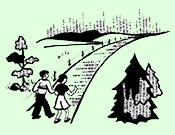
By Lois E. Wilson
“Wind” is defined as a natural movement of air of any velocity. It’s is the very air that keeps us alive. When the wind is calm, one hardly notices it is there. When blowing, it may carry odors you smell, move objects you see, you may hear the gusts and feel them as they touch your face. If it carries foreign particles, the wind may have a taste.
The word “wind” has crept into our vocabulary:
An over talkative person may be a bag of wind, a windbag, windy, or worse, full of hot air.
A heat spell can be baked wind. An accordion is a wind box. In public, we try not to break wind.
Wind shear is when there is a change in wind speed and/or direction over a short distance.
The trachea is called the windpipe. There are windshields on vehicles. In research wind tunnels are used. At airports there are wind socks used to indicate the direction of the wind. A windswept landscape may be dotted with wind turbines creating energy.
There are sayings about the wind:
An ill wind blows no good.
They’re just testing to see which way the wind blows before they decide what to do.
“Blow, blow, thou winter wind, thou art not so unkind as man’s ingratitude.” (Shakespeare)
The force of wind from low level to high is known by different terms: breeze, gust, strong, whirlwind, gale, tornado, tropical storm, and hurricane are some of these.
Compressed air is to inflate objects such as tires, balls, beds, rafts, play houses, etc. Some hot air balloons rely on on-board burners to heat up air in them to generate lift. Jeannette Piccard described it this way, “When you fly a balloon, you don’t file a flight plan; you go where the wind goes. You feel like part of the air. You almost feel like part of eternity, and you just float along.”
Books and films have also included “wind” in titles:
The 1928 film “The Wind” tells the story of the people in a town battling the elements of a dustbowl. “Wind” is about competitive yacht racing. Other films and books are: “The Wind in the Willows”, “Wind Chill”, “The Wind and the Lion,” The best known of these is the 1939 film from Margaret Mitchell’s book, “Gone with the Wind.”
During our lifetimes, all of us are confronted with challenges and obstacles which seem to have us stumped and at a standstill not able to rise above them toward success. Euripides observed, “Human misery must somewhere have a stop: there is no wind that always blows a storm.”
With a little energy (heat) like the hot air balloon, we can rise above the problems. Henry Ford put it this way: “When everything seems to be going against you—remember the airplane takes off against the wind, not with it.”

